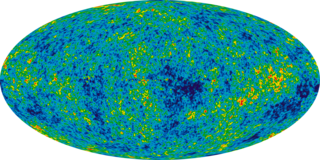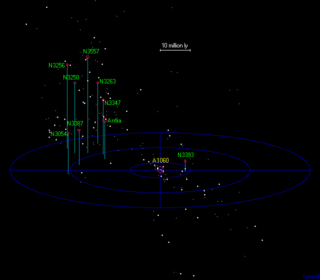Related Research Articles

The IC 342/Maffei Group corresponds to one or two galaxy groups close to the Local Group. The member galaxies are mostly concentrated around either IC 342 or Maffei 1, which would be the brightest two galaxies in the group. The group is part of the Virgo Supercluster. However, recent studies have found that the two subgroups are unrelated; while the IC 342 group is the nearest galaxy group to the Milky Way, the Maffei 1 group is several times farther away, and is not gravitationally bound to the IC 342 group.

A supercluster is a large group of smaller galaxy clusters or galaxy groups; they are among the largest known structures in the universe. The Milky Way is part of the Local Group galaxy group, which in turn is part of the Virgo Supercluster, which is part of the Laniakea Supercluster, which is part of the Pisces–Cetus Supercluster Complex. The large size and low density of superclusters means that they, unlike clusters, expand with the Hubble expansion. The number of superclusters in the observable universe is estimated to be 10 million.

The following is a timeline of galaxies, clusters of galaxies, and large-scale structure of the universe.

The Virgo Supercluster or the Local Supercluster was a formerly defined supercluster containing the Virgo Cluster and Local Group, which itself contains the Milky Way and Andromeda galaxies, as well as others. At least 100 galaxy groups and clusters are located within its diameter of 33 megaparsecs. The Virgo SC is one of about 10 million superclusters in the observable universe and is in the Pisces–Cetus Supercluster Complex, a galaxy filament.

The Great Attractor is a region of gravitational attraction in intergalactic space and the apparent central gravitational point of the Laniakea Supercluster of galaxies that includes the Milky Way galaxy, as well as about 100,000 other galaxies.

The Zone of Avoidance, or Zone of Galactic Obscuration (ZGO), is the area of the sky that is obscured by the Milky Way.

The Hydra–Centaurus Supercluster, or the Hydra and Centaurus Superclusters, was a previously defined supercluster in two parts, which prior to the identification of Laniakea Supercluster in 2014 is the closest neighbour of the former Virgo Supercluster. Its center is located about 39 Mpc (127 Mly) away, with it extending to a maximum distance of around 69 Mpc (225 Mly).

The Pavo–Indus Supercluster is a neighboring supercluster located about 60–70 Mpc (196–228 Mly) away in the constellations of Pavo, Indus, and Telescopium. The supercluster contains three main clusters, Abell 3656, Abell 3698, and Abell 3742.

Knowledge of the location of Earth has been shaped by 400 years of telescopic observations, and has expanded radically since the start of the 20th century. Initially, Earth was believed to be the center of the Universe, which consisted only of those planets visible with the naked eye and an outlying sphere of fixed stars. After the acceptance of the heliocentric model in the 17th century, observations by William Herschel and others showed that the Sun lay within a vast, disc-shaped galaxy of stars. By the 20th century, observations of spiral nebulae revealed that the Milky Way galaxy was one of billions in an expanding universe, grouped into clusters and superclusters. By the end of the 20th century, the overall structure of the visible universe was becoming clearer, with superclusters forming into a vast web of filaments and voids. Superclusters, filaments and voids are the largest coherent structures in the Universe that we can observe. At still larger scales the Universe becomes homogeneous, meaning that all its parts have on average the same density, composition and structure.

In cosmology, galaxy filaments are the largest known structures in the universe, consisting of walls of galactic superclusters. These massive, thread-like formations can commonly reach 50/h to 80/h Megaparsecs —with the largest found to date being the Hercules-Corona Borealis Great Wall at around 3 gigaparsecs (9.8 Gly) in length—and form the boundaries between voids. Due to the accelerating expansion of the universe, the individual clusters of gravitationally bound galaxies that make up galaxy filaments are moving away from each other at an accelerated rate; in the far future they will dissolve.
The Pisces–Cetus Supercluster Complex is a galaxy filament. It includes the Laniakea Supercluster which contains the Virgo Supercluster lobe which in turn contains the Local Group, the galaxy cluster that includes the Milky Way. This filament is adjacent to the Perseus–Pegasus Filament.

The Laniakea Supercluster or the Local Supercluster is the galaxy supercluster that is home to the Milky Way and approximately 100,000 other nearby galaxies.
The Vela Supercluster (Vela SCl, VSCL) is a massive galactic supercluster about 265.5 megaparsecs (870 million light-years) away within the vicinity of the Zone of Avoidance, centered on the constellation Vela. It is one of the largest structures found in the universe, covering about 25 × 20 degrees of the sky. It consists of two walls: a broad main wall and a secondary merging wall. The combined dimensions of the walls are 115 km/s Mpc on the major dimensions and 90 km/s Mpc on the minor ones, which corresponds to about 385 million and 300 million light years, respectively. It is about 1,000 times the mass of the Milky Way galaxy, which corresponds to a mass of 1 × 1015 M☉. About 20 initial galaxy clusters have been identified spectroscopically.

The Southern Supercluster is a nearby supercluster located around 19.5 Mpc (63.6 Mly) in the constellations of Cetus, Fornax, Eridanus, Horologium, and Dorado. It was first identified in 1953 by Gérard de Vaucouleurs.

The South Pole Wall is a massive cosmic structure formed by a giant wall of galaxies that extends across at least 1.37 billion light-years of space, the nearest light of which is aged about half a billion light-years. The structure, in its astronomical angle, is dense in five known places including one very near to the celestial South Pole and is, according to the international team of astronomers that discovered the South Pole Wall, "...the largest contiguous feature in the local volume and comparable to the Sloan Great Wall at half the distance ...". Its discovery was announced by Daniel Pomarède of Paris-Saclay University and R. Brent Tully and colleagues of the University of Hawaiʻi in July 2020. Pomarède explained, "One might wonder how such a large and not-so distant structure remained unnoticed. This is due to its location in a region of the sky that has not been completely surveyed, and where direct observations are hindered by foreground patches of galactic dust and clouds. We have found it thanks to its gravitational influence, imprinted in the velocities of a sample of galaxies".
The Telescopium−Grus Cloud is a galaxy filament in the constellations of Pavo, Indus, and Telescopium. It was first defined by astronomer Brent Tully in his book The Nearby Galaxies Atlas and its companion book The Nearby Galaxies Catalog.

The Local Volume is a collection of more than 500 galaxies located in an area of the observable universe near us, within a spherical region with a radius of 11 megaparsecs from Earth or up to a radial velocity of redshift of z < 0.002.
The Southern Supercluster Strand is a galaxy filament that incompasses the Southern Supercluster and the Telescopium−Grus Cloud.
References
- 1 2 3 Henning, P. A.; Springob, C. M.; Minchin, R. F.; et al. (June 2010). "The Arecibo L-band Feed Array Zone of Avoidance Survey. I. Precursor Observations Through the Inner and Outer Galaxy". The Astronomical Journal . 139 (6): 2130–47. arXiv: 1002.2933 . Bibcode:2010AJ....139.2130H. doi: 10.1088/0004-6256/139/6/2130 .
- 1 2 3 4 Donley, Jennifer L.; Staveley-Smith, L.; Kraan-Korteweg, R. C.; et al. (January 2005). "The H I Parkes Zone of Avoidance Survey: The Northern Extension". The Astronomical Journal . 129 (1): 220–38. arXiv: astro-ph/0409570 . Bibcode: 2005AJ....129..220D . doi: 10.1086/426320 . original data from Fairall, A. P. 1998, Large-Scale Structures in the Local Universe (Chichester: Wiley)
- ↑ Powell, Richard. "The Perseus-Pisces Supercluster." Atlas of the Universe. Web. Retrieved 18 Oct. 2015.
- ↑ Wegner, Gary; Haynes, Martha P.; Giovanelli, Riccardo (April 1993). "A Survey of the Pisces–Perseus. V. The Declination Strip +33.5 degrees to +39.5 degrees and the Main Supercluster Ridge". The Astronomical Journal . 105 (4): 1251–70. Bibcode: 1993AJ....105.1251W . doi: 10.1086/116507 .
- 1 2 3 Giovanelli, Riccardo; Haynes, Martha P.; Chincarini, Guido L. (January 1986). "Morphological Segregation in the Pisces–Perseus Supercluster". The Astrophysical Journal . 300: 77–92. Bibcode: 1986ApJ...300...77G . doi: 10.1086/163784 .
{{cite journal}}: CS1 maint: date and year (link) - 1 2 Tully, R. Brent; Courtois, Hélène; Hoffman, Yehuda; Pomarède, Daniel (3 September 2014). "The Laniakea Supercluster of Galaxies". Nature . 513 (7516): 71–73. arXiv: 1409.0880 . Bibcode:2014Natur.513...71T. doi:10.1038/nature13674. PMID 25186900. S2CID 205240232.
- 1 2 Lu, Nanyao Y.; Freudling, Wolfram (1994). Balkowski, C.; Kraan-Korteweg, C. (eds.). "Large-Scale Structures in the Highly Obscured Orion–Taurus Region". Astronomical Society of the Pacific Conference Series . 67: 238–48. Bibcode: 1994ASPC...67..239L .
- ↑ Marzke, Ronald O.; Huchra, John P.; Geller, Margaret J. (November 1996). "Large-Scale Structure at Low Galactic Latitude". The Astronomical Journal . 112 (5): 1803–11, 2356–7. Bibcode: 1996AJ....112.1803M . doi: 10.1086/118142 .
- ↑ Erdoǧdu, Pirin; Lahav, Ofer; Huchra, John P.; et al. (November 2006). "Reconstructed density and velocity fields from the 2MASS Redshift Survey" (PDF). Monthly Notices of the Royal Astronomical Society . 373 (1): 45–64. arXiv: astro-ph/0610005 . Bibcode: 2006MNRAS.373...45E . doi: 10.1111/j.1365-2966.2006.11049.x . Archived (PDF) from the original on 26 July 2018.
- ↑ ALFA ZOA Team. "The Arecibo Zone of Avoidance Survey (ALFAZOA)." Arecibo Observatory, 5 Oct. 2015. Web. Retrieved 18 Oct. 2015.
- ↑ ALFA Team at Cornell. "The Arecibo Legacy Fast ALFA Survey." Arecibo Observatory, 1 Apr. 2013 Web. Retrieved 18 Oct. 2015.